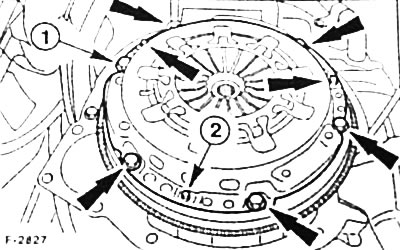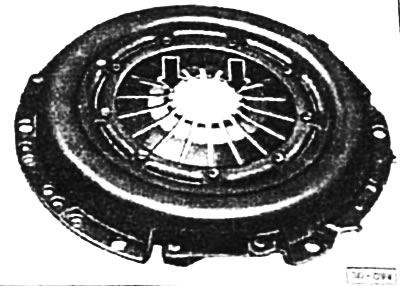Withdrawal
Remove the gearbox see p. 89.
To prevent the flywheel from turning when the bolts are loosened, fix it at the ring gear with a screwdriver and a pin.

bolts (outer arrows and -1-) Loosen the fasteners of the pressure plate to the flywheel in a cross way by 1-1.5 turns to reduce the tension of the pressure plate.
Attention: If the bolts are completely unscrewed immediately, the diaphragm spring may be damaged.
After that, unscrew the fastening bolts completely.
Remove the clutch pressure and driven discs.
Attention: When taking out the discs, do not drop them, otherwise, after assembly, difficulties may arise associated with pulling the clutch and separating the discs.
Wipe the flywheel with a gasoline-soaked rag.
Examination
If the old pressure or, respectively, driven clutch plates are installed, they should be checked before installation.
Replace clutch discs with traces of oil and grease, as well as with mechanical damage.

Check the thickness of the lining of the clutch disc using a vernier caliper. The distance to the rivet heads must be at least 0.3 mm, otherwise replace the driven disk. If cracks are found on the linings, the disc must also be replaced.

Check pressure plate. Examine the diaphragm spring for signs of wear at the point of contact with the clutch release bearing. The ends of the diaphragm spring -arrows- can be worn down to a depth of 0.3 mm.
Check the spring connections between the pressure plate and the cover for cracks, the strength of the rivet joints. Replace clutch with damaged or loose rivets.

Check the contact surface of the pressure plate for cracks, burns and wear. Pressure plates with inward deflections up to 0.3 mm can be reinstalled. The check is carried out with a metal ruler and a feeler gauge.
Check the flywheel for cracks from burns and bumps.
Go over the pressure plate with very fine sandpaper.
At the service station, the clutch disc can be checked for runout. Lateral runout should not exceed 0.25 mm.
Attention. Such a check is required when the previous driven disk is installed and the clutch was previously turned off incorrectly.
Check the clutch release bearing in the gearbox housing. There should be no visible pressure marks on the bearing. Turn the bearing by hand. It should spin easily. A bearing that makes noise when the clutch pedal is depressed must be replaced, see p. 86.
Installation
Attention. Before installing a new clutch, remove the protective varnish from the friction surfaces of the pressure plate with a solvent and, if necessary, wipe the flywheel.
Apply a thin layer of special grease to the spline connection of the input shaft and the guide bushing (Microlube GL-261) At the same time, grease all surfaces of the splines.
Attention. Do not over-lubricate, as excess lubricant is thrown onto friction surfaces and impairs clutch operation. Using a different lubricant can also cause clutch failure.
Check that the dowel pins for the clutch cover are firmly seated on the flywheel.

Align the drive plate by eye in the center of the pressure plate. However, it is best to use a suitable pin for this, for example. HAZET 2174 or old transmission drive shaft. At the service station, a special FORD 21-044A tool is used for this. If the driven plate is not centered, the gearbox input shaft cannot be inserted.
Put the pressure plate together with the centered driven plate on the flywheel. In this case, the flat side of the driven disk with the inscription Flywheel Side / Schwungradseite must face the flywheel (to the engine). Observe the position of the centering pins. see figure F-2B27 (internal arrows and -2-).
Insert and screw by hand the bolts of the pressure plate.
Tighten the pressure plate mounting bolts sequentially in a criss-cross pattern by 1-1½ turns until the pressure plate is firmly tightened.
Attention: Do not warp the pressure plate when tightening the bolts. The tightening torque of the pressure plate mounting bolts is 30 Nm.
Remove center pin.
Install the gearbox see p. 90.
Visitor comments